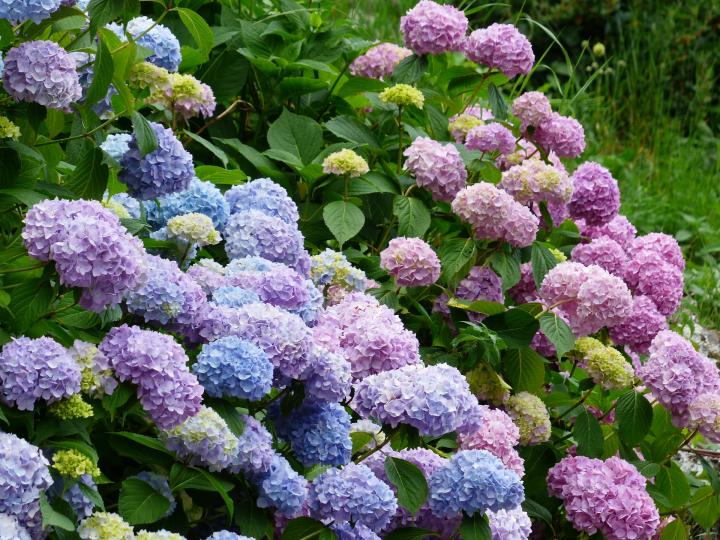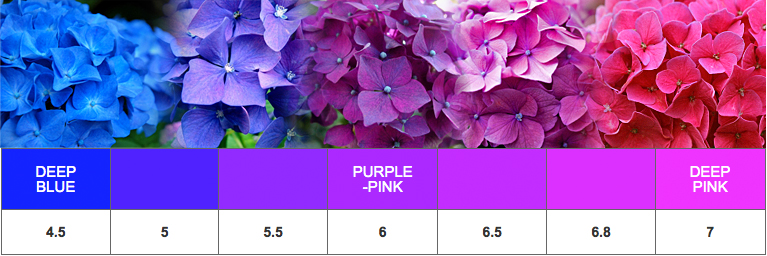To change the color of hydrangeas, you can manipulate the soil pH. By adjusting the acidity or alkalinity of the soil, you can alter the color of the flowers.

Credit: www.almanac.com
Introduction To Hydrangeas
Hydrangeas are popular garden plants known for their gorgeous and vibrant blooms. These versatile flowers come in a wide range of colors, including blue, pink, purple, and white. The color of the hydrangea blooms is determined by the pH level of the soil, with acidic soil producing blue flowers and alkaline soil resulting in pink flowers.
In addition to their stunning aesthetic appeal, hydrangeas also hold symbolic significance in various cultures, representing gratitude, heartfelt emotions, and abundance. With their captivating beauty and rich symbolism, hydrangeas are a beloved choice for gardens, weddings, and floral arrangements.
Science Behind Hydrangea Colors
The color of hydrangea flowers is determined by the soil pH. Acidic soil (pH less than 6) produces blue flowers, while alkaline soil (pH greater than 7) results in pink flowers. The presence of aluminum ions in the soil also influences the color.
In acidic soil, aluminum ions are available to the plant, leading to blue flowers. In alkaline soil, the availability of aluminum ions decreases, causing the flowers to turn pink. Understanding the science behind hydrangea colors allows gardeners to manipulate the soil pH to achieve their desired flower color.
Assessing Your Soil
Before changing the color of your hydrangeas, it’s important to assess your soil. Testing the pH level of your soil is crucial as it affects the ability of your plants to absorb nutrients. You can easily purchase a soil testing kit from your local gardening store or online.
Understanding the composition of your soil is also important. Hydrangeas thrive in soil that is rich in organic matter and well-draining. If your soil is lacking in nutrients, consider adding compost or a balanced fertilizer to improve its quality.
By taking these steps to assess your soil, you can ensure that your hydrangeas will have the best chance to thrive and change color successfully.
Altering Soil Ph
When altering soil pH to change the color of hydrangeas, it’s important to understand the impact of pH levels. To achieve blue hues, acidifying the soil to a pH of 5.5 or lower is necessary. This can be done by adding aluminum sulfate or sulfur to the soil.
Conversely, for pink shades, the soil should be alkalized to a pH of 6.5 or higher. This can be achieved by adding garden lime to the soil. It’s essential to test the soil’s pH before making any amendments and to regularly monitor the pH levels throughout the growing season.
By carefully managing the soil pH, it is possible to manipulate the color of hydrangea blooms and enjoy a stunning display of vibrant hues.
The Role Of Fertilizers
Hydrangeas are popular for their stunning colors, and changing their color can be a fun experiment for gardeners. Fertilizers play a crucial role in determining the color of hydrangeas.
Choosing the right fertilizer is important to achieve the desired color. For blue hydrangeas, use a fertilizer that is low in phosphorus and high in aluminum and iron. For pink hydrangeas, use a fertilizer that is high in phosphorus and low in aluminum and iron.
Application techniques and timing also play a vital role in changing the color of hydrangeas. Apply the fertilizer evenly around the base of the plant and water it well. For blue hydrangeas, apply the fertilizer in early spring before new growth appears. For pink hydrangeas, apply the fertilizer in late winter or early spring.
Caring For Hydrangeas
Hydrangeas are beautiful flowering plants that can enhance the beauty of any garden. Proper care and maintenance are essential for the healthy growth of hydrangeas.
Watering Practices
Hydrangeas require regular watering, especially during the growing season. The soil should be kept moist but not waterlogged, as too much water can cause the roots to rot. It is advisable to water the plants deeply once a week, rather than shallow watering every day. Mulching can help retain moisture in the soil and prevent evaporation.
Pruning And Maintenance
Pruning is essential for the healthy growth of hydrangeas. Dead and damaged branches should be removed regularly. It is advisable to prune the plants in late winter or early spring before the new growth starts. Fertilizing the plants once a month during the growing season can enhance their growth and flowering.
| Watering | Pruning | Maintenance |
|---|---|---|
| Water deeply once a week | Remove dead and damaged branches regularly | Fertilize once a month during growing season |
| Keep soil moist but not waterlogged | Prune in late winter or early spring | Regularly check for pests and diseases |
| Mulch to retain moisture |
Troubleshooting Common Issues
Color Fading: Ensure adequate sunlight and moisture levels for vibrant color. Test soil pH and adjust if necessary. Consider changing the location of the plant for better conditions.
Improper Color Changes: Check for any recent changes in the environment, such as new construction or landscaping. Assess for any exposure to chemicals or pollutants that could be affecting the color.

Credit: www.lorraineballato.com
Creative Tips And Tricks
Hydrangeas are beautiful flowers that come in different colors. If you want to change the color of your hydrangeas, there are some creative tips and tricks that you can follow.
One way to enhance the colors of your hydrangeas naturally is by using coffee grounds. This method is suitable for blue and purple hydrangeas, and you can simply sprinkle coffee grounds around the base of the plant.
Another way to enhance the colors of your hydrangeas is by using eggshells. Eggshells contain calcium that can help change the color of your hydrangeas. Crush the eggshells and spread them around the base of the plant to see the results.
| Using Color Enhancers Safely |
|---|
| When using color enhancers on your hydrangeas, it is essential to follow some safety tips: |
| – Wear gloves to protect your hands from any chemicals. |
| – Avoid using too much fertilizer, as it can harm your plants. |
| – Always read the instructions on the package before using any color enhancers. |

Credit: www.plantingtree.com
Frequently Asked Questions
Do Coffee Grounds Change The Color Of Hydrangeas?
Yes, coffee grounds can change the color of hydrangeas due to their acidic nature. Adding coffee grounds to the soil can lower the pH level, leading to blue blooms on the hydrangea plant.
Can You Change The Color Of Hydrangeas?
Yes, you can change the color of hydrangeas by altering the pH level of the soil. Adding aluminum sulfate for blue blooms or lime for pink ones can modify the color.
How Does Vinegar Change The Color Of Hydrangeas?
Vinegar changes the color of hydrangeas by altering the pH level of the soil. Acidic soil caused by vinegar makes the flowers turn blue, while alkaline soil makes them pink. The acidity affects the availability of aluminum ions in the soil, which determines the color of the hydrangeas.
Does Epsom Salts Change The Colour Of Hydrangeas?
Yes, Epsom salts can change the color of hydrangeas. When applied to the soil, the magnesium in Epsom salts can alter the pH levels, resulting in pink or blue blooms. Adding Epsom salts to the soil may intensify the color of the hydrangeas.
Conclusion
Changing the color of hydrangeas can be a rewarding and creative endeavor for any gardener. By understanding the factors that influence color, such as soil pH and variety selection, you can achieve stunning results.
Remember to conduct thorough research, follow proper techniques, and be patient, as it may take time to see the desired color transformation.
With these tips in mind, you’ll be well on your way to enjoying a vibrant and colorful hydrangea garden. Happy gardening!
- 25 Low Light Pet-Safe Indoor Plants: Safe for Pets & Perfect for Low Light! - September 18, 2024
- 15 Best Indoor Plants for Beginners: Care Tips & Guide - September 17, 2024
- 32 Best Indoor Plants for Air Purification Safe for Pets - September 16, 2024
